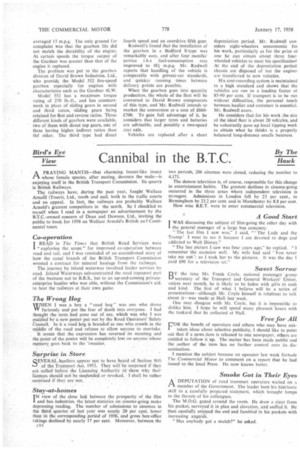M m.p.g.
Page 53

Page 54

If you've noticed an error in this article please click here to report it so we can fix it.
With 8-ton Payloads
Yorkshire Haulier Instals 'Gardner Engine and D.B. Gearbox in Bedford Chassis With Successful Results
By G. Duncan Jewell
AN operator with definite ideas on the specification of the vehicles most suited to his work is Mr. J. T. todwell, of T. Rodwell and Son. Ltd., Voodside Garage, Wombwell, near larnsley. Experiments in this direction tarted over 30 years ago when a Gardner 'our-cylindered 'engine was installed in a _eyland chassis. Since then every ,chicle run by the .company has had a ,o,,ver unit of similar manufacture.
As fuel controller for the Barnsley irea during the war, chairman of the eorkShire road-rail committee and direcor of an 85-vehicle unit of the Ministry if War Transport, Mr. Rodwell became mrivinced of the importance of sound_ Ind economic 'transport operation.• Today the company • specialize in iarrying lots of from 5 cwt. Co 5 tons, ind the average vehicle load is .about 8 mis. Three vehicles are employed on inflections and deliveries in Yorkshire. tnd a Scatnrqell articulated outfit is conrolled by radio from Wombwell,' where clads destined for the long-distance Pellicles are assembled.
Al the time of nationalization, the
company possessed 19 vehicles mainly engaged upon smalls traffic and covering routes to Newcastle upon Tyne, Teesside, Southampton, the southwestern peninsula and South Wales. After acquisition, Rodwell Motors, Ltd., were formed as general vehicle engineers and became recommended Gardner stockists, carrying a full range of spare parts and being equipped with all necessary servicing facilities_ When denationalization came in 1954. Mr. Rodwell decided that the two companies should function independently, and on the haulage side assessed . his vehicle requirements for long-distance smalls traffic. He reckoned that 30-m.p.h. vehicles of 7-8-ton capacity would be the most efficient. From previous experience ii was considered that a Gardner four-cylindered engine would give appropriate power, and a contributory consideration was this unifs reputation for long life. The widespread service facilities and ready availability. of reasonably priced spares further led to the selection of chassis of
Bedford manufacture. • Special-A-licence vehicles were' purchased and replac'ed by new Bedford vehicles, the engines of which were removed and Gardner units installed..
The neat conversion made by the company entailed only a minor repositioning of the engine; and slight modification of the cab and cowling. The height of the Gardner engine involved some alterations to the sump, and the • front springs required an extra leaf. The cylinder head covers were changed, and special rubber mountings were fitted to reduce vibration.
Whereas the original six-cylindered engines returned 13 m.p.g.. the Gardners averaged 17 m.p.g. The only ground for complaint was that the gearbox life did not match the durability of the engine. At certain speeds the torque output of the Gardner was greater than that of the engine it replaced.
The problem was put to the gearbox division of David Brown Industries, Ltd., who provide the Model 552 five-speed gearbox especially for engines with characteristics such as the Gardner 4LW.
Model 552 has a maximum torque rating of 270 lb.-ft., and has constantmesh in place of sliding gears in second and third ratios, sliding gears being retained for first and reverse ratios, Three different kinds of gearbox were available. two of them with direct top gears, one of these having higher indirect ratios than thd other. The third type had direct fourth speed and an overdrive fifth gear.
Rodwell's found that the installation of the gearbox in a Bedford S-type was remarkably easy, and after four months' service t h e fuel-consumption rate improved to 181 m.p.g. Mr. Rodwell reports that handling of the vehicle is comparable with private-ear standards, and quicker running times between delivery points are possible.
When the gearbox goes into quantity production, the whole of the fleet will be converted to David Brown components of this type, and Mr. Rodwell intends to market the conversion at a cost of £660£700. To gain full advantage of it, he _considers that larger tyres and batteries are advisable, and possibly a two-speed rear axle.
Vehicles are replaced after a short
depreciation period. Mr. Rodwell con• siders eight-wheelers uneconomic foi his work, particularly as for the price ol one he can obtain about three four. wheeled vehicles to meet his specification At the end of the depreciation period chassis are disposed of but the engine, are transferred to new vehicles.
His cost-recording system is maintained to a high standard and shows that the vehicles are run to a loading factor of 85-90 per cent. If transport is to be run without difficulties, the personal touch between haulier and customer is essential. Mr. Rodwell avers.
He considers that for his work the size of the ideal fleet is about 20 vehicles, and he voluntarily gave up local tipping work to obtain what he thinks is a properly balanced long-distance smalls business.
















































































































